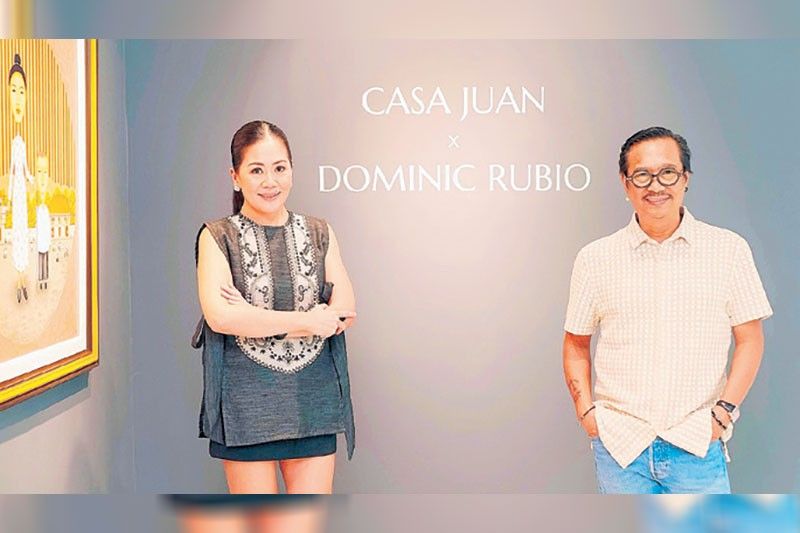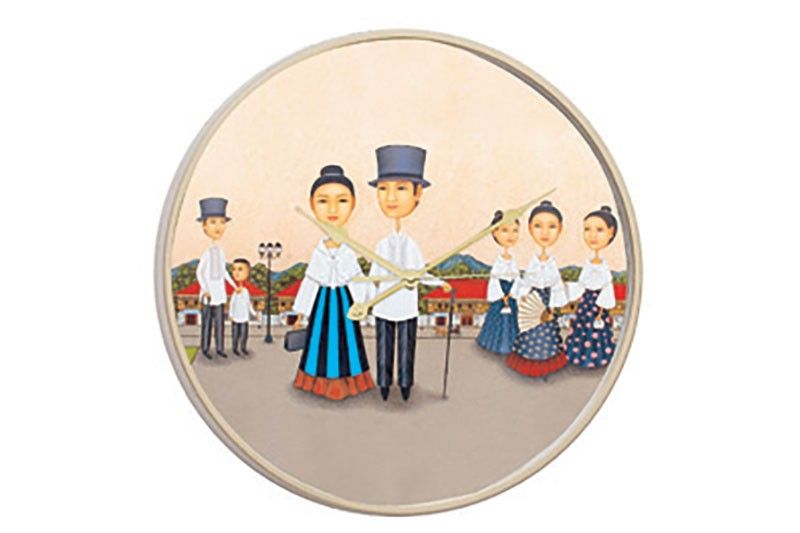Dominic Rubio's function in art

Casa Juan expands its Filipino homeware line with a limited-edition collection of side tables, jewelry boxes, clocks, and serving trays by Filipino contemporary artist Dominic Rubio. The functional art collection proposes a new way of appreciating and integrating Rubio’s distinctive “people types” wearing turn-of-the-century Philippine attire. Casa Juan Founder Michelle Asence Fontelera said, “We expanded our collection to include trays, clocks, jewelry boxes and tables. The idea was to promote purposeful Filipino art. This is art that you can actually use. The collection also homes in on the idea of ‘art for all.’”
Dominic Rubio was born in 1970 in Paete, Laguna, the town well known for its woodcarvings. This was an early indication that heritage and artistry would be an integral part of his life. He honed his techniques as a visual artist at the Santo Tomas College of Fine Arts where he majored in Commercial Arts.

Rubio then worked as an artist for one of the country’s largest advertising agencies but later relocated to the more tranquil shores of Pearl Farm in Davao del Sur. That is where he connected with the landscapes, people and way of life in Northern Mindanao. His explorations of the southern region also allowed him to live among the Mandaya and T’boli tribes as well as the Bilaans and Badjaos. Rubio’s early works depicted the quintessential Filipina in her most natural forms and surroundings.
The pairing between Casa Juan and Rubio was bound by a shared desire to make art more accessible. It was also brought to life and set in motion by Galerie Joaquin. This would be Rubio’s first time to lend his artistry to merchandise. He elaborates: “Matagal na ino-offer sa ’kin na gawin merchandise yung mga painting ko. Special ito sa ’kin kasi nashe-share ko yung Filipino way of life sa mga tao na tumatangkilik ng art. Sana ’wag natin kalimutan ang sarili nating kultura, lalo na sa mga artists. Thankful rin ako sa Galerie Joaquin, sila talaga nag-asikaso sa pag-develop nito. Masaya ako kasi ngayon, hindi lang sa painting or sculpture makikita ang mga gawa ko. Maibabahagi ko na siya sa mga taong mahilig sa art, kolektor man o hindi. At saka functional art siya; pwede talagang gamiit. (I’ve been getting offers to apply my paintings into merchandise for some time. This collection with Casa Juan is special for me because I can bring elements of the Filipino way of life to art enthusiasts. My hope is that we remember to celebrate our culture and heritage, especially as artists. I am also thankful to Galerie Joaquin for being an integral part of this collaboration. I’m happy because now, my works can also be enjoyed through functional art pieces that can truly be used at home).”
Fontelera adds, “I have long admired and collected the works of Dominic Rubio. They strike me as a modern version of Tipos del Pais (types of country). More than that, I am an avid supporter of Philippine art. So, I sought out ways to collaborate with more artists to bring a piece of the Philippines and Filipino artistry into more homes. Featured in this special collection of objets d’art (art objects) are prints from Rubio’s Paseo en Moto and Sol Dorado. With pieces from this special partnership, Casa Juan and Rubio impart the value in celebrating our culture, identity as a people, and our distinct way of life.”
Rubio says of Sol Dorado: “(It) means ‘golden sun’ in Spanish. This shows how Filipino men, women and children used to live in the olden times. In this painting, people get dressed up to go to the plaza. They wear the Philippine national dress in different styles. I wanted to stay true to the designs of those times. The past has always been an inspiration for me. This painting is a nostalgic portrayal of Manila. It also portrays the Spanish influences that have helped to shape our culture — in the way we dress, our society, and architecture. It was a beautiful time that I thoroughly enjoyed painting.”

On Paseo en Moto, he explains: “Paseo en Moto means ‘motorcycle ride’ in Spanish. I’ve always been drawn to titles that are either in Tagalog or Spanish. It’s more authentic. I’ve also always loved painting couples riding a motorbike. For this piece, I was inspired by Vespa. In Paseo en Moto I imagined a couple from the Spanish times on a joyride around the city. The irony in this piece is that there were no Vespas during that era. But I found it amusing in any case to imagine because if you think about it, Vespas have that quality about them that almost feel like they come from the olden times. Very retro. I love to spend time in the province and explore on an ATV (all-terrain vehicle). After spending some time away from the city, I find myself inspired by the time I return to painting. Lately, I’ve been incorporating this aspect of life into my work. I decided I wanted something new, so I added a Vespa as a subject. It was still a fit since it has the same neo-genre effect. For Paseo en Moto, I combined elements from different eras — the old and the new. Both are actually timeless and bring something special to any space.”
* * *
These limited functional-art pieces are available at Galerie Joaquin in Power Plant Mall, Rockwell, Makati, or order by messaging @casajuanmnl on Instagram.
Follow me on Instagram @pepperteehankee.
- Latest




























